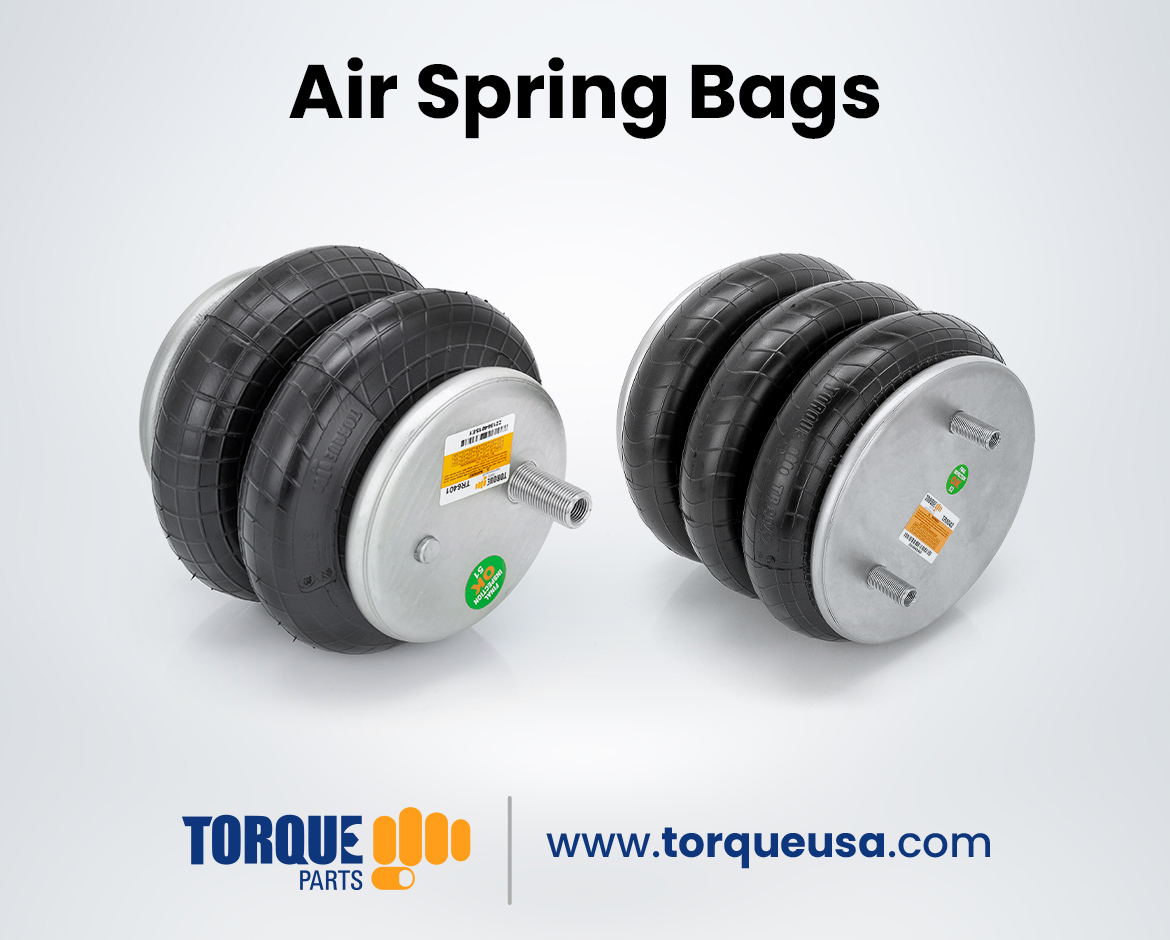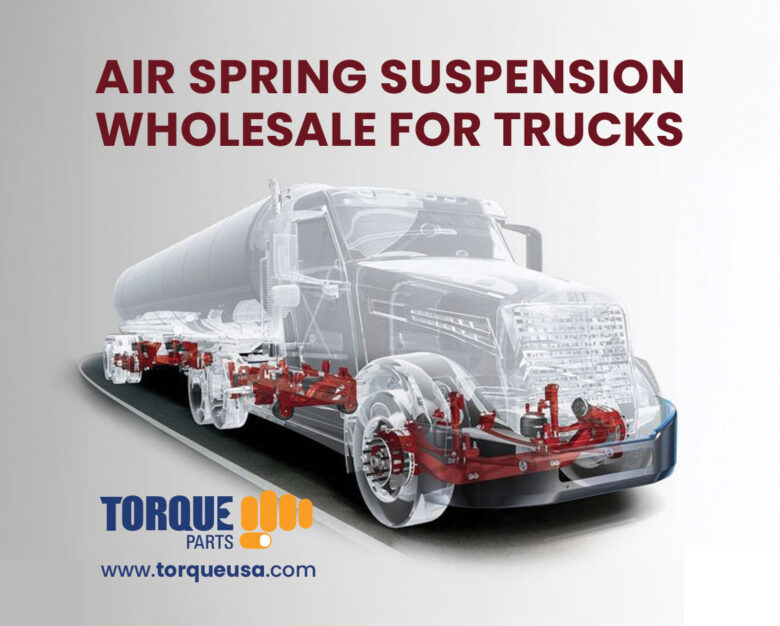
Everything You Need to Know About Air Spring Bags: Benefits, Installation, Maintenance, and FAQs
Introduction to Air Spring Bags
Air spring bags, also known as air suspension systems, are an increasingly popular choice for vehicles that require a smooth, comfortable ride. These systems use compressed air to provide support and absorb shocks, rather than relying solely on metal springs or other traditional suspension components.
The purpose of air spring bags is to improve the overall ride quality of a vehicle, particularly for large or heavy vehicles that may experience more bumps and jolts on the road. Air spring bags work by using air pressure to adjust the stiffness and height of the suspension system, depending on the specific driving conditions.
One of the key benefits of air spring bags is that they can be adjusted to suit a variety of road surfaces and driving situations. For example, if a vehicle needs to navigate over rough terrain, the air pressure in the spring bags can be increased to provide more support and stability. On the other hand, if the vehicle is driving on a smooth highway, the air pressure can be lowered to create a more comfortable ride.
Overall, air spring bags are an important component of modern vehicle suspension systems. They offer a range of benefits for drivers and passengers, and can be customized to fit the needs of a wide range of vehicles and driving conditions. However, it’s important to properly maintain and care for air spring bags in order to ensure their longevity and effectiveness.
Air Spring Bags
Benefits of Air Spring Bags
Air spring bags offer a range of benefits for vehicles and drivers, particularly when compared to traditional suspension systems. Here are some of the key advantages of using air spring bags:
1. Improved ride quality and comfort
Air spring bags are designed to absorb shocks and bumps on the road, resulting in a smoother, more comfortable ride for drivers and passengers. This is particularly important for large or heavy vehicles, which may otherwise experience a lot of jostling and shaking on uneven surfaces.
2. Increased stability and handling
Air spring bags provide more stability and control over the vehicle, especially when navigating tight turns or high speeds. They also distribute weight more evenly across the vehicle, which can reduce wear and tear on other suspension components.
3. Ability to adjust ride height for different road conditions
One of the biggest advantages of air spring bags is their ability to adjust the ride height of a vehicle depending on the driving conditions. This can be particularly useful for off-road vehicles, which may need more clearance over rough terrain, or for sports cars that require a lower profile for better aerodynamics.
4. Longer lifespan compared to traditional suspension systems
Air spring bags are often more durable and longer-lasting than traditional suspension systems, which can wear out or become damaged over time. This can save drivers money on repairs and replacement parts in the long run.
Overall, air spring bags offer a range of benefits for vehicles and drivers, from improved ride quality and comfort to increased stability and control. If you’re considering upgrading your suspension system, air spring bags may be a great option to explore.
Components of Air Spring Bags
Air spring bags are made up of several key components that work together to provide support and absorb shocks. Here are the main components of air spring bags:
1. Rubber or polyurethane airbag
The airbag is the most visible component of the air spring system, and is responsible for providing support and absorbing shocks. Airbags are typically made from rubber or polyurethane, and are designed to be flexible and durable.
2. Steel or aluminum piston
The piston is located inside the airbag, and works to regulate the flow of air in and out of the system. Pistons are typically made from steel or aluminum, and are designed to withstand high pressure and temperature changes.
3. Air compressor and air lines
The air compressor is responsible for pumping air into the airbag, while the air lines transport the air between the compressor and the airbag. These components work together to maintain the appropriate level of air pressure in the system.
4. Electronic control system
The electronic control system is responsible for monitoring the air pressure in the system, and adjusting it as needed to maintain the desired ride height and stiffness. This system typically includes sensors, a control module, and a display or interface for the driver to use.
Overall, the components of air spring bags work together to provide a smoother, more comfortable ride for drivers and passengers. It’s important to ensure that all of these components are properly maintained and functioning correctly in order to ensure the longevity and effectiveness of the system.
Air Spring Bag Installation
Installing air spring bags can be a complex process, and it’s important to follow the manufacturer’s instructions carefully in order to ensure the system is installed correctly. Here are some key considerations for air spring bag installation:
1. Tools and equipment needed for installation
Before beginning the installation process, it’s important to make sure you have all of the necessary tools and equipment on hand. This may include items such as a jack, socket set, torque wrench, and wire cutters.
2. Step-by-step installation process
The installation process for air spring bags will vary depending on the specific make and model of your vehicle, as well as the air spring bag system you’re installing. It’s important to carefully read the manufacturer’s instructions and follow them step-by-step to ensure the system is installed correctly.
3. Common mistakes to avoid during installation
There are several common mistakes that can occur during air spring bag installation, such as over-tightening bolts or damaging the air lines. It’s important to take your time during the installation process and double-check your work to avoid these errors.
It’s also worth noting that air spring bag installation can be a complex and time-consuming process, and may require professional installation in some cases. If you’re not confident in your ability to install air spring bags yourself, it may be best to hire a professional to handle the installation for you.
Air Spring Bag Maintenance
Proper maintenance is essential for ensuring the longevity and effectiveness of your air spring bag system. Here are some key considerations for air spring bag maintenance:
1. Recommended maintenance schedule
It’s important to follow the manufacturer’s recommended maintenance schedule for your air spring bag system. This may include tasks such as inspecting the system for damage, checking the air pressure, and lubricating moving parts.
2. Inspection checklist for air spring bags
Regular inspections are an important part of air spring bag maintenance. When inspecting your system, make sure to check for signs of damage or wear and tear, such as cracks in the airbag or leaks in the air lines.
3. How to troubleshoot common issues
If you notice any issues with your air spring bag system, such as a loss of air pressure or uneven ride height, it’s important to troubleshoot the issue as soon as possible. This may involve checking the air lines for leaks, or adjusting the air pressure in the system.
4. Importance of replacing air spring bags when necessary
Over time, air spring bags may wear out or become damaged, and may need to be replaced. It’s important to replace air spring bags when necessary in order to ensure the continued effectiveness and safety of your suspension system.
Overall, proper maintenance and care is essential for ensuring the longevity and effectiveness of your air spring bag system. By following the manufacturer’s recommended maintenance schedule and staying vigilant for signs of damage or wear and tear, you can help extend the life of your system and keep it running smoothly for years to come.
Upgrading to Air Spring Bags
If you’re considering upgrading your vehicle’s suspension system, air spring bags may be a great option to explore. Here are some key considerations for upgrading to air spring bags:
1. Benefits of upgrading from traditional suspension systems
Air spring bags offer several key benefits when compared to traditional suspension systems, including improved ride quality and comfort, increased stability and control, and the ability to adjust the ride height for different driving conditions.
2. Cost considerations and budgeting for an upgrade
Upgrading to air spring bags can be a significant investment, and it’s important to consider the costs involved before making a decision. This may include the cost of the air spring bags themselves, as well as installation costs and any necessary upgrades to the vehicle’s electronic control system.
3. Popular air spring bag brands and models
There are many different air spring bag brands and models available on the market, each with their own unique features and benefits. It’s important to research different options and choose a system that best fits your vehicle and driving needs.
4. Hiring a professional for installation
Installing air spring bags can be a complex process, and may require specialized knowledge and equipment. If you’re not confident in your ability to install air spring bags yourself, it may be best to hire a professional to handle the installation for you.
Overall, upgrading to air spring bags can offer a range of benefits for your vehicle and driving experience. However, it’s important to carefully consider the costs and logistics involved before making a decision, and to choose a reputable brand and installer for the best results.
Air Spring Bag FAQs
If you’re considering air spring bags for your vehicle, you may have some questions or concerns about the system. Here are some frequently asked questions and answers about air spring bags:
1. Are air spring bags compatible with all vehicles?
Air spring bags can be compatible with a wide range of vehicles, including cars, trucks, SUVs, and RVs. However, it’s important to choose a system that is specifically designed for your vehicle and driving needs.
2. Can air spring bags be installed on any type of terrain?
Air spring bags can be used on a variety of different terrains, including highways, city streets, and off-road trails. However, it’s important to adjust the air pressure in the system to suit the specific driving conditions.
3. How long do air spring bags typically last?
The lifespan of air spring bags can vary depending on a variety of factors, such as the quality of the system, how often it’s used, and how well it’s maintained. However, air spring bags are generally designed to last for several years with proper maintenance and care.
4. How much does it cost to install air spring bags?
The cost of installing air spring bags can vary depending on a variety of factors, such as the specific make and model of the system, the complexity of the installation process, and any necessary upgrades to the vehicle’s electronic control system. It’s important to get a quote from a reputable installer before making a decision.
5. Can I install air spring bags myself?
While it is possible to install air spring bags yourself, it can be a complex process that requires specialized knowledge and equipment. If you’re not confident in your ability to install air spring bags, it’s best to hire a professional to handle the installation for you.
Overall, air spring bags can offer a range of benefits for vehicles and drivers, but it’s important to carefully consider the logistics and maintenance involved before making a decision. If you have any additional questions or concerns about air spring bags, be sure to consult with a reputable installer or manufacturer.
Conclusion
Air spring bags are an important component of modern vehicle suspension systems, offering a range of benefits for drivers and passengers. From improved ride quality and comfort to increased stability and control, air spring bags can be a great option for a wide range of vehicles and driving conditions.
However, it’s important to carefully consider the costs and logistics involved in installing and maintaining air spring bags, and to choose a reputable brand and installer for the best results. By following the manufacturer’s recommended maintenance schedule and staying vigilant for signs of damage or wear and tear, you can help ensure the longevity and effectiveness of your air spring bag system.
If you’re considering air spring bags for your vehicle, be sure to do your research and choose a system that best fits your specific needs and driving conditions. With proper installation and maintenance, air spring bags can offer a smoother, more comfortable ride for years to come.
For detailed information, you can contact us at
Air Spring Bags


